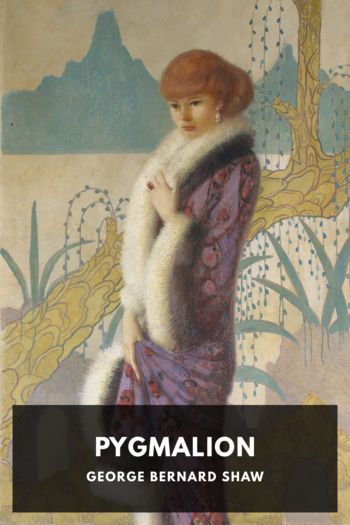Bulfinch’s Mythology Thomas Bulfinch (intellectual books to read TXT) 📖

- Author: Thomas Bulfinch
Book online «Bulfinch’s Mythology Thomas Bulfinch (intellectual books to read TXT) 📖». Author Thomas Bulfinch
The hauberk was a complete covering of double chain mail. Some hauberks opened before, like a modern coat; others were closed like a shirt.
The chain mail of which they were composed was formed by a number of iron links, each link having others inserted into it, the whole exhibiting a kind of network, of which (in some instances at least) the meshes were circular, with each link separately riveted.
The hauberk was proof against the most violent blow of a sword; but the point of a lance might pass through the meshes, or drive the iron into the flesh. To guard against this, a thick and well-stuffed doublet was worn underneath, under which was commonly added an iron breastplate. Hence the expression “to pierce both plate and mail,” so common in the earlier poets.
Mail armor continued in general use till about the year 1300, when it was gradually supplanted by plate armor, or suits consisting of pieces or plates of solid iron, adapted to the different parts of the body.
Shields were generally made of wood, covered with leather, or some similar substance. To secure them, in some sort, from being cut through by the sword, they were surrounded with a hoop of metal.
HelmetsThe helmet was composed of two parts: the headpiece, which was strengthened within by several circles of iron, and the visor, which, as the name implies, was a sort of grating to see through, so contrived as, by sliding in a groove, or turning on a pivot, to be raised or lowered at pleasure. Some helmets had a further improvement called a bever, from the Italian bevere, to drink. The ventayle, or “air-passage,” is another name for this.
To secure the helmet from the possibility of falling, or of being struck off, it was tied by several laces to the meshes of the hauberk; consequently, when a knight was overthrown it was necessary to undo these laces before he could be put to death; though this was sometimes effected by lifting up the skirt of the hauberk, and stabbing him in the belly. The instrument of death was a small dagger, worn on the right side.
RomancesIn ages when there were no books, when noblemen and princes themselves could not read, history or tradition was monopolized by the storytellers. They inherited, generation after generation, the wondrous tales of their predecessors, which they retailed to the public with such additions of their own as their acquired information supplied them with. Anachronisms became of course very common, and errors of geography, of locality, of manners, equally so. Spurious genealogies were invented, in which Arthur and his knights, and Charlemagne and his paladins, were made to derive their descent from Aeneas, Hector, or some other of the Trojan heroes.
With regard to the derivation of the word “Romance,” we trace it to the fact that the dialects which were formed in Western Europe, from the admixture of Latin with the native languages, took the name of Langue Romaine. The French language was divided into two dialects. The river Loire was their common boundary. In the provinces to the south of that river the affirmative, yes, was expressed by the word oc; in the north it was called oil (oui); and hence Dante has named the southern language langue d’oc, and the northern langue d’oil. The latter, which was carried into England by the Normans, and is the origin of the present French, may be called the French Romane; and the former the Provençal, or Provencial Romane, because it was spoken by the people of Provence and Languedoc, southern provinces of France.
These dialects were soon distinguished by very opposite characters. A soft and enervating climate, a spirit of commerce encouraged by an easy communication with other maritime nations, the influx of wealth, and a more settled government, may have tended to polish and soften the diction of the Provencials, whose poets, under the name of Troubadours, were the masters of the Italians, and particularly of Petrarch. Their favorite pieces were Sirventes (satirical pieces), love-songs, and Ténsons, which last were a sort of dialogue in verse between two poets, who questioned each other on some refined points of loves’ casuistry. It seems the Provencials were so completely absorbed in these delicate questions as to neglect and despise the composition of fabulous histories of adventure and knighthood, which they left in a great measure to the poets of the northern part of the kingdom, called Trouveurs.
At a time when chivalry excited universal admiration, and when all the efforts of that chivalry were directed against the enemies of religion, it was natural that literature should receive the same impulse, and that history and fable should be ransacked to furnish examples of courage and piety that might excite increased emulation. Arthur and Charlemagne were the two heroes selected for this purpose. Arthur’s pretensions were that he was a brave, though not always a successful warrior; he had withstood with great resolution the arms of the infidels, that is to say of the Saxons, and his memory was held in the highest estimation by his countrymen, the Britons, who carried with them into Wales, and into the kindred country of Armorica, or Brittany, the memory of his exploits, which their national vanity insensibly exaggerated, till the little prince of the Silures (South Wales) was magnified into the conqueror of England, of Gaul, and of the greater part of Europe. His genealogy was gradually carried up to





Comments (0)